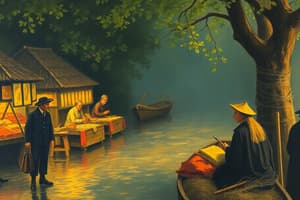Podcast
Questions and Answers
Economists define ______________ as 'limited quantities to meet unlimited wants.'
Economists define ______________ as 'limited quantities to meet unlimited wants.'
scarcity
All decisions involve __________________ because we must give up some alternatives when we choose a certain course of action.
All decisions involve __________________ because we must give up some alternatives when we choose a certain course of action.
trade-offs
The term _______ refers to all natural resources that are used to produce goods and services.
The term _______ refers to all natural resources that are used to produce goods and services.
land
Economists use the phrase _________________________ to describe the trade-offs a country is forced to make when choosing between military and consumer production.
Economists use the phrase _________________________ to describe the trade-offs a country is forced to make when choosing between military and consumer production.
An ____________________ is the most important sacrifice that results from making a decision.
An ____________________ is the most important sacrifice that results from making a decision.
A person who starts a new business or develops an original idea is known as an ______________________.
A person who starts a new business or develops an original idea is known as an ______________________.
____________________ of resources occurs when an economy uses fewer resources than it is capable of expending.
____________________ of resources occurs when an economy uses fewer resources than it is capable of expending.
Using examples of land, labor, and capital, explain why economists believe that all goods and services are scarce.
Using examples of land, labor, and capital, explain why economists believe that all goods and services are scarce.
Explain how each of the following people would talk about scarcity and trade-offs: (a) the President of the United States (b) the leader of a developing nation (c) a U.S. citizen whose income is in the top 1 percent (d) a U.S. citizen whose income is in the bottom 5 percent.
Explain how each of the following people would talk about scarcity and trade-offs: (a) the President of the United States (b) the leader of a developing nation (c) a U.S. citizen whose income is in the top 1 percent (d) a U.S. citizen whose income is in the bottom 5 percent.
What 3 important pieces of information can we learn by reading a production possibilities graph?
What 3 important pieces of information can we learn by reading a production possibilities graph?
Explain the law of increasing costs.
Explain the law of increasing costs.
Describe 3 services that the government provides to its citizens and identify some of the opportunity costs of providing each of those services.
Describe 3 services that the government provides to its citizens and identify some of the opportunity costs of providing each of those services.
What relationship does the line graph describe?
What relationship does the line graph describe?
What is the average annual income of men with 16 years of education?
What is the average annual income of men with 16 years of education?
How many years of schooling result in an average annual income of $64,000 for women?
How many years of schooling result in an average annual income of $64,000 for women?
What could you conclude from the line graph about the relationship between income and education?
What could you conclude from the line graph about the relationship between income and education?
Flashcards are hidden until you start studying
Study Notes
Scarcity and Economic Concepts
- Scarcity is defined as "limited quantities to meet unlimited wants."
- Trade-offs occur because choosing one action necessitates giving up alternatives.
- Opportunity cost is the most significant sacrifice made when a decision is made.
Factors of Production
- Land includes all natural resources used for production (e.g., coal, water, forests).
- Labor represents the effort given to tasks for which individuals receive payment (e.g., medical services by doctors).
- Capital comprises both human capital (knowledge and skills gained through education and experience) and physical capital (human-made items like buildings and tools).
Economic Trade-offs
- "Guns or butter" illustrates the trade-offs nations must consider between military and consumer goods.
- Underutilization of resources indicates that an economy operates below its capacity.
Economic Perspectives
- The President views scarcity in terms of defense versus public goods.
- A leader of a developing nation may prioritize resource allocation between capital goods and consumer goods.
- A U.S. citizen in the top 1% is likely unaffected by scarcity, while one in the bottom 5% is acutely aware of it.
Production and Economic Analysis
- Production possibilities graphs convey information about opportunity costs, economic growth, and efficiency.
- The law of increasing costs shows that reallocating resources necessitates more effort as production shifts from one item to another.
Government Services and Opportunity Costs
- Social Security funding comes at the opportunity cost of personal investment potential.
- Increased spending on highways could detract from improvements in public transportation.
- Military spending may limit funding for essential sectors like housing and education.
Income and Education Insights
- The line graph shows a positive correlation between years of schooling and annual income.
- Men with 16 years of education earn an average of $65,000 annually.
- Women require 20 years of schooling to achieve an average annual income of $64,000.
- Higher levels of education are associated with increased income potential.
Studying That Suits You
Use AI to generate personalized quizzes and flashcards to suit your learning preferences.




